|
Want
to know more about Kurdistan?
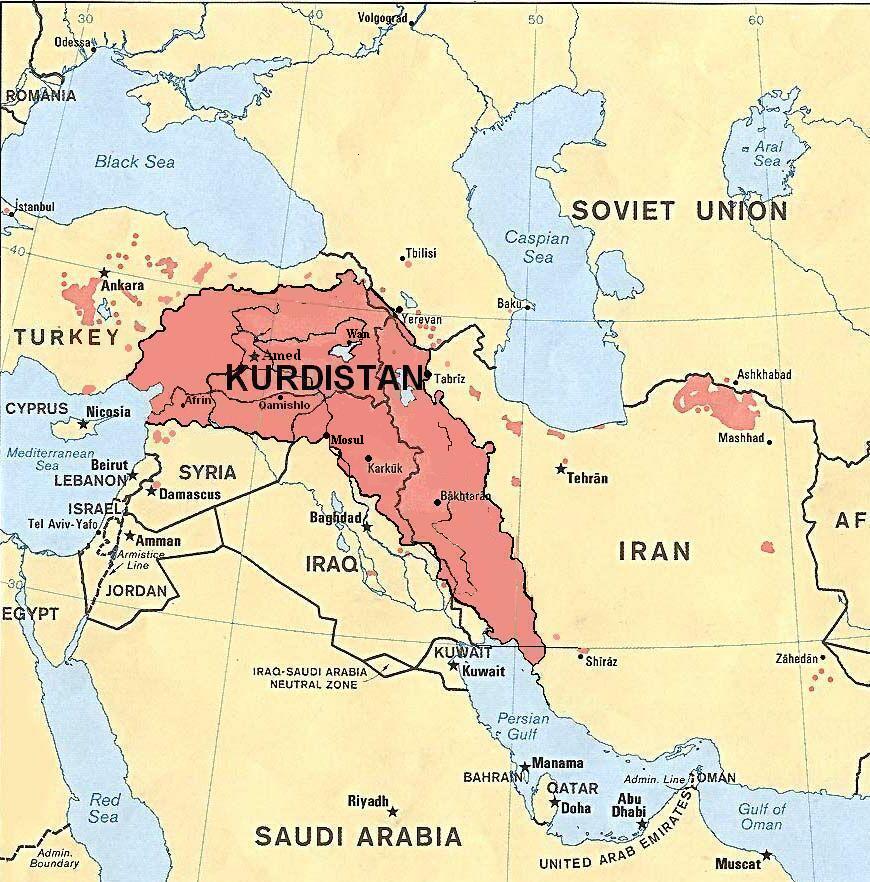
|
| Contemporary Kurdistan's Map |
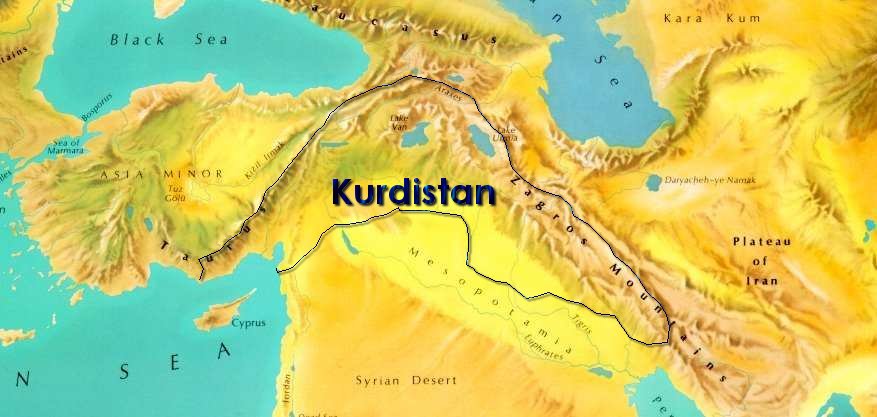
|
| This is the Kurdistan's Map which was drawn by the League of Nations in Paris after WW1 in 1924 |
The number of
Kurds in the four parts of Kurdistan and within the borders of the four countries that have divided it up between themselves
totals about 52 million. This makes the Kurds, one of the largest nation in the Near East or Middle East, like Persians,
Israelis, Arabs, turks, etc and if not more in case of population size. Kurdistan, which has since time immemorial
been inhabited by the Kurds, has a territory of 500,000 square km, which is as large as that of France (for this purpose I
have published few maps below). In other words, the Kurds are not a minority in their country; they are the majority. The
Kurdish question is not the problem of a minority of the population of this or that country; it is the question of a divided
and illegally occupied country and an oppressed nation. Like all other nations, the Kurdistani too have the
right to self-determination. The borders that divide Kurdistan are neither natural, economic, nor cultural borders. They are
artificial borders that have been drawn against the will of the Kurdish people according to the interests of the forces that
did the dividing and the balance of power. In many cases these borders have divided villages, towns, even families, and have
had divisive and destructive effects on economic, social, and cultural life. The largest part of Kurdistan, which in terms
of both its population and its territory makes up about one-half of the total, lies in the north inside the state borders
of Turkey. This part amounts to one-third of the total territory of Turkey, and includes more than twenty provinces in the
"eastern and northeastern regions". Other parts, according to their size, are eastern Kurdistan (within the borders of Iran),
southern Kurdistan (within the borders of Iraq), and Southwestern Kurdistan ( within the borders of Syria
). In all of these parts a large number of the inhabitants - between 85 and 95% - are Kurds. A certain proportion of the Kurds
have lived since earlier times, or because of the migrations and refugee movements of recent times, in other regions and in
the large cities of these countries. If we count these as well, then about 24 million Kurds live in Northern Kurdistan
[ Kurdistan ], 12 million in Eastern Kurdistan [ Iran ], 8 million in Southern Kurdistan [ Iraq ], and 4
million in Western Kurdistan [ Syria ].
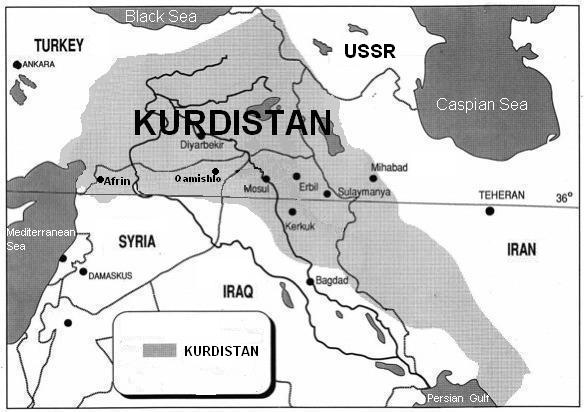
|
| This Kurdistan Map was handed to the League of Nations in Geneva in1938, by the Kurdish delegation |
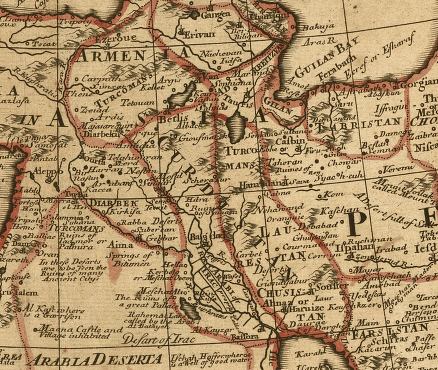
|
| Historic map from 1721, showing borders of Curdistan ( Kurdistan ) provinces |
KURDISTAN
HISTORY:
Being the native inhabitants of their land. there are no "beginnings" for Kurdish history and people. Kurds
and their history are the end products of thousands of years of continuous internal evolution and assimilation of new peoples
and ideas introduced sporadically into their land. Genetically, Kurds are the descendants of all those who ever came to settle
in Kurdistan, and not any one of them. A people such as the Guti, Kurti. Mede, Mard, Carduchi, Gordyene, Adianbene, Zila and
Khaldi signify not the ancestor of the Kurds but only an ancestor.
Archaeological finds continue to document that
some of mankind's earliest steps towards development of agnculture. domes- tication of many common farm animals (sheep, goats,
hogs and dogs). record keep- ing (the token system), development of domestic technologies (weavmg, fired pot- tery making
and glazing), metallurgy and urbanization took place in Kurdistan, dating back between 12,000 and 8.000 years ago.
The
earliest evidence so far of a unified and distinct culture (and possibly, ethnicity) by people inhabiting the Kurdish moun-
tains dates back to the Halaf culture of 8,000-7,400 years ago. This was followed by the spread of the Ubaidian culture, which
was a foreign introduction from Mesopotamia. After about a millennium, its dominance was replaced by the Hurrian culture,
which may or may not have been the Halafian people reasserting their domi- nance over their mountainous homeland. The Hurrian
period lasted from 6,300 to about 2,600 years ago.
Much more is known of the Hurrians. They spoke a language of the
Northeast Caucasian family of languages (or Alarodian), kin to modern Chechen and Lezgian. The Hurrians spread far and wide,
dominating much territory outside their Zagros-Taurus mountain base. Their settlement of Anatolia was complete-all the way
to the Aegean coasts. Like their Kurdish descendents, they however did not expand too far from the mountains. Their intrusions
into the neighboring plains of Mesopotamia and the Iranian Pteau, there- fore, were primarily military annexations with little
population settlement. Their economy was surprisingly integrated and focused, along with their political bonds, mainly running
parallel with the Zagros- Taurus mountains, rather than radiating out to the lowlands, as was the case during the preceding
(foreign) Ubaid cultural period. The mountain-plain economic exchanges remained secondary in importance, judging by the archaeological
remains of goods and their origin.
The Hurrians-whose name survives now most prominently in the dialect and district
of Hawraman/Awraman in Kurdistan- divided into many clans and subgroups, who set up city-states, kingdoms and empires known
today after their respvi hective clan names. These included the Gutis, Kurti, Khadi, Mards, Mushku, Manna, Hatti, Mittanni,
Urartu, and the Kassitis1es, to name just a few. All these were Hurrians, and together form the Hurrian phase of Kurdish history.
By about 4.000 years ago, the first van- guard of the Indo-European-speaking peoples were trickling into Kurdistan
in limited numbers and settling there. These formed the aristocracy of the Mittani, Kassite, and Hittite kingdoms, while the
common peopies there remained solidly Hurrian. By about 3,000 years ago, the trickle had turned into a flood, and Hurrian
Kurdistan was fast becoming Indo-European Kurdistan. Far from having been wiped out, the Hurrian legacy, despite its linguistic
eclipse, remains the single most important element of the Kurdish culture until today. It forms the substructure for every
aspects of Kurdish existence, from their native reli- gion to their art, their social organization, women's status, and even
the form of their militia warfare.
Medes, Scythians and Sagarthians are just the better-known clans of the Indo- European-speaking
Aryans who settled in Kurdistan. By about 2,600 years ago, the Medes had already set up an empire that included all Kurdistan
and vast territories far beyond. Medeans were followed by scores of other kingdoms and city-statesQall dom- inated by Aryan
aristocracies and a populace that was becoming Indo-European, Kurdish speakers if not so already.
By the advent of
the classical era in 300 BC. Kurds were already experiencing massive population movements that resulted in settlement and
domination of many neighboring regions. Important Kurdish polities of this time were all byproducts of these movements. The
Zelan Kurdish clan of Commagene (Adyaman area), for example, spread to establish in addition to the Zelanid dynasty of Commagene,
the Zelanid kingdom of Cappadocia and the Zelanid empire of PontusQall in Anatolia. These became Roman vassals by the end
of the Ist century BC. In the east the Kurdish kingdoms of Gordyene, Cortea, Media, Kirm, and Adiabene had, by the I st century
B C, become confederate members of the Parthian Federation.
While all larger Kurdish Kingdoms of the west gradually
lost their existence to the Romans, in the east they survived into the 3rd century A D and the advent of the Sasanian Persian
empire. The last major Kurdish dynasty, the Kayosids, fell in AD 380. Smaller Kurdish principalities (called the Kotyar, "mountain
administrators") however, preserved their autonomous existence into the 7th century and the coming of Islam.
Several
socio-economic revolutions in the garb of religious movements emerged in Kurdistan at this time, many due to the exploitation
by central governments, some due to natural disasters. These continued as underground movement into the Islamic era, bursting
forth periodically to demand social reforms. The Mazdakite and Khurramite movements are best-known among these.
The
eclipse of the Sasanian and Byzantine power by the Muslim caliphate, and its own subsequent weakening, permitted the Kurdish
principalities and "mountain administrators" to set up new, independent states. The Shaddadids of the Caucasus and Armenia,
the Rawadids of Azerbaijan, the Marwandis of eastern Anatolia; the Hasanwayhids, Fadhilwayhids, and Ayyarids of the central
Zagros and the Shabankara of Fars and Kirman are some of the medieval Kurdish dynasties.
The Ayyubids stand out from
these by the vastness of their domain. From their capital at Cairo they ruled territories of eastern Libya, Egypt, Yemen,
western Arabia, Syria, the Holy Lands, Armenia and much of Kurdistan. As the custodians of Islam's holy cities of Mecca, Medina
and Jerusalem, the Ayyubids were instrumental in the defeat and expulsion of the Crusaders from the Holy Land.
With
the 12th and 13th centuries the Turkic nomads arrived in the area who in time politically dominated vast segments of the Middle
East. Most independent Kurdish states succumbed to various Turkic kingdoms and empires. Kurdish principalities, however, survived
and continued with their autonomous existence until the 17th century. Intermittently, these would rule independently when
local empires weakened or collapsed.
The advent of the Safavid and Ottoman empires in the area and their division
of Kurdistan into two uneven imperial dependencies was on a par with the practice of the preceding few centuries. Their introduction
of artillery and scorched-earth policy into Kurdistan was a new, and devastating development.
In the course of the
16th to 18th centuries, vast portions of Kurdistan were systematically devastated and large numbers of Kurds were deported
to far corners of the Safavid and Ottoman empires. The magnitude of death and destruction wrought on Kurdistan unified its
people in their call to rid the land of these foreign vandals. The lasting mutual suffenng awakened in Kurds a community feelingQa
nationalism, that called for a unified Kurdish state and fostering of Kurdish culture and language. Thus the historian Sharaf
al-Din Bitlisi wrote the first pan-Kurdish history the Sharafnama in 1597, as Ahmad Khani composed the national epic of Mem-o-Zin
in 1695, which called for a Kurdish state to fend for its people. Kurdish nationalism was born.
For one last time
a large Kurdish kingdomQthe Zand, was born in 1750. Like the medieval Ayyubids, however, the Zands set up their capital and
kingdom outside Kurdistan, and pursued no policies aimed at unification of the Kurdish nation. By 1867, the very last autonomous
Kurdish principalities were being systematically eradicated by the Ottoman and Persian governments that ruled Kurdistan. They
now ruled directly, via governors, all Kurdish provinces. The situation further deteriorated after the end of the WWI and
dissolution of the Ottoman Empire.
The Treaty of Sevres (signed August 10, 1921) anticipated an independent Kurdish
state to cover large portions of the former Ottoman Kurdistan. Unimpressed by the Kurds' many bloody uprisings for independence,
France and Britain divided up Ottoman Kurdistan between Turkey, Syria and Iraq. The Treaty of Lausanne (signed June 24, 1923)
formalized this division. Kurds of Persia/Iran, meanwhile, were kept where they were by Teheran.
Drawing of well-guarded
state boundaries dividing Kurdistan has, since 1921, aMicted Kurdish society with such a degree of fragmentation, that its
impact is tearing apar the Kurds' unity as a nation. The 1920s saw the setting up of Kurdish Autonomous Province (the "Red
Kurdistan") in Soviet Azerbaijan. It was disbanded in 1929. In 1945, Kurds set up a Kurdish republic at Mahabad in the Sovie,
occupied zone in Iran. It lasted one year, until it was reoccupied by the Iranian army.
Since 1970s, the Iraqi Kurds
have enjoyed an official autonomous status in a portion of that state's Kurdistan. By the end of 1991, they had become all
but independent from Iraq. By 1995, however, the Kurdish government in Arbil was at the verge of political suicide due to
the outbreak of factional fighting between various Kurdish warlords.
Since 1987 the Kurds in TurkeyQby themselves
constituting a majority of all KurdsQhave waged a war of national liberation against Ankara's 70 years of heavyhanded suppression
of any vestige of the Kurdish identity and its rich and ancient culture. The massive uprising had by 1995 propelled Turkey
into a state of civil war. The burgeoning and youthful Kurdish population in Turkey, is now demanding absolute equality with
the Turkish component in that state, and failing that, full independence.
In the Caucasus, the fledgling Armenian
Republic, in the course of 1992-94 wiped out the entire Kurdish community of the former "Red Kurdistan." Having ethnically
"cleansed" it, Armenia has effectively annexed Red Kurdistan's temtory that forms the land bridge between the Armenian enclave
of Nagorno-Karabakh and Armenia proper. |
Click Here For Kurdistan History From Wikipedia (A Neutral account of Kurdistan History)
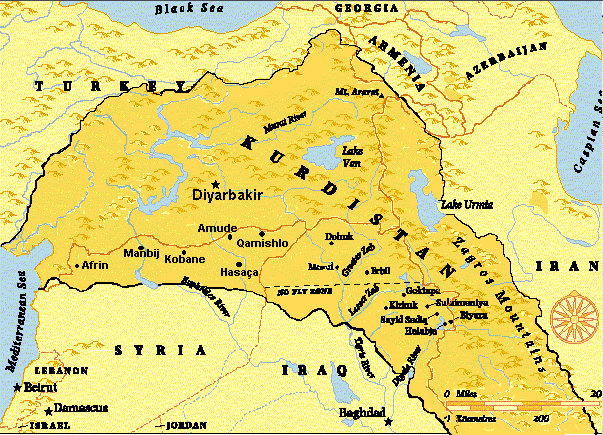
|
| Kurdistan's Map |
KURDISH LANGUAGE:
Kurds are speakers of Kurdish, a member of the
northwestern subdivision of the Iranic branch of the Indo-Europian family of languages, which is akin to Persian, and by extension
to other Europian languages. It is fundamentally different from Semetic Arabic and Altaic Turkish. Modern Kurdish divides
into two major groups: 1) the Kurmanji group and, 2) the Dimili-Gurani group [ See below for more detials in the Map].
These are supplemented by scores of sub-dialects as well. The most popular vernacular is that of Kurmanji(or Kirmancha), spoken
by about three-quarters of the Kurds today. Kurmanji divided into North Kurmanji(also called Bahdinani, with around 20
million speakers, primarily in central and North Western Kurdistan and the former Soviet Union) and South
Kurmanji(also called Sorani, with about 12 million speakers, primarily in South Eastern Kurdistan).
To the far
north of Kurdistan along Kizil Irmak and Murat rivers in Turkey, Dimili(less accurately but more commonly known as Zaza) dialect
is spoken by about 4 million Kurds. There are small pockets of this language spoken in various croners of Anatolia, northern
Iraq, northern Iran and the Caucasus as well.
In the far Southern Kurdistan, ( Iraq and Iran ), the Gurani dialect
is spoken by about 3 million Kurds. Gurani along with its two major subdivisions: Laki and Awramani, merit special attention
for its wealth of sacred and secular literature stretching over a millennium.
The Kurds: A Concise Handbook by Mehrdad
R. Izady (This information should not be considered as a 'fact'---The KIN).
In South and Eastern Kurdistan (
Iraq and Iran ) a modified version of the Perso-Arabic alphabet has been adapted to South Kurmani(Sorani). The Kurds
of Northern( Turkey ) have recently embarked on an extensive campaign of publication in the North Kurmanji dialect
of Kurmaji (Bahdinani) from their publishing houses in Europe. these employed a modified form of the Latin alphabet. The Kurds
of the former Soviet Union first began writing Kurdish in the Armenian alphabet in the 1920s, followed by Latin in 1927 ,
then Cyrillic in 1945, and now in both Cyrilic and Latin. Gurani dialects continue to employ the Persian alphabet without
any change. Dimili now uses the same modified Latin alphabet as North Kurmanji for print.
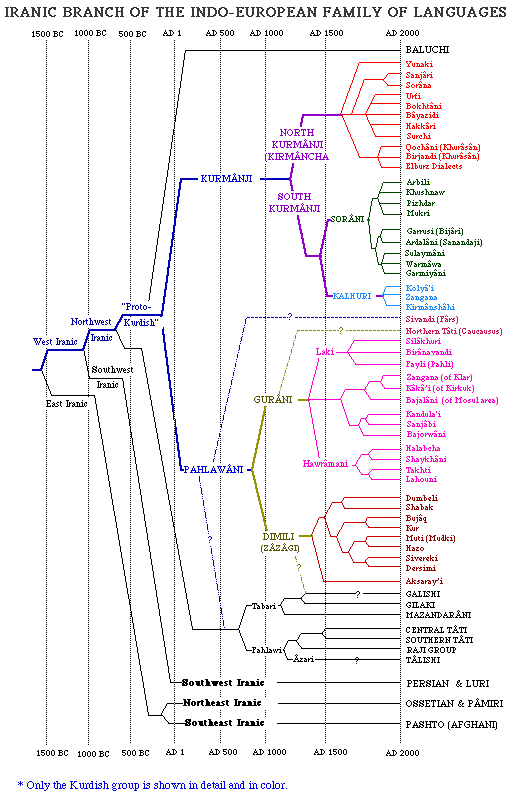
The Genealogy of Kurdish Language
|
Sources: The Kurds, A Concise Handbook, By Dr. Mehrdad
R. Izady, Dep. of Near Easter Languages and Civilazation Harvard University, USA, 1992
Please note that the spelling system of the author which
conforms with the most common English rendition of Kurdish
names
and terms has been fully maintained here.
|
RELIGION IN KURDISTAN:
Nearly three fifths of the Kurds, almost all
Kurmanji-speakers, are today at least nominally Sunni Muslims of Shafiite rite. There are also some followers of mainstream
Shiitem Islam among the Kurds, particularly in and around the cities of Kirmanshah, to Hamadan and Bijar in southern and eastern
Kurdistan and the Khurasan. These Siite Kurds number around half a million. The overwhelming majority of Muslim Kurds are
followers of one several mystic Sufi orders, most importantly the Bektashi order of the northwest Kurdistan, the Naqshbandi
order in the west and north, Qadiri orders of east and central Kurdistan, and Nurbakhshi of the south.
Zerk rituals
are held at the Pir-e Shahriyar's house, in a hall roughly as large as 5*10m located at the extreme of the house. A man holding
a Takht-e Guiveh left from the Pir is sitting on a platform at the end of the hall so the people kiss it for blessing. Mam-Wasta
(the village clergy) with his white turban, sits by the top platform. After all people gather, they play the Daf and start
chanting the Zekr. [From Kurdistan by N. Kasraian, Z. Arshi, and K. Zabihi]
The rest of the Kurds are followers of
several indigenous Kurdish faiths of great antiquit and originality, which are variations on and permutation of an ancient
religion that can be reasonably but loosely labeled as Yardanism or the "Cult of Angels." The three surviving major divisions
of this religion are Yezidism (in west and west-central Kurdistan, ca 2%of all Kurds), Yarsanism or the Ahl-i Haqq (in southern
Kurdistan, ca 13% of all Kurds), and Alevism or Kizil Bash(in western Kurdistan and the Khurasan, ca 20%).
Minor communities
of Kurdish Jews, Christians and Baha'is are found in various croners of Kurdistan. the ancient Jewish community has progressively
emigrated to Israel, while the Christian community is merging their identity with that of the Assyrians.
The Big Mosque,
Mosul-Kurdistan, where The Kurdish governer Imadadin Zengi ruled and The Great Salahaddin grew up
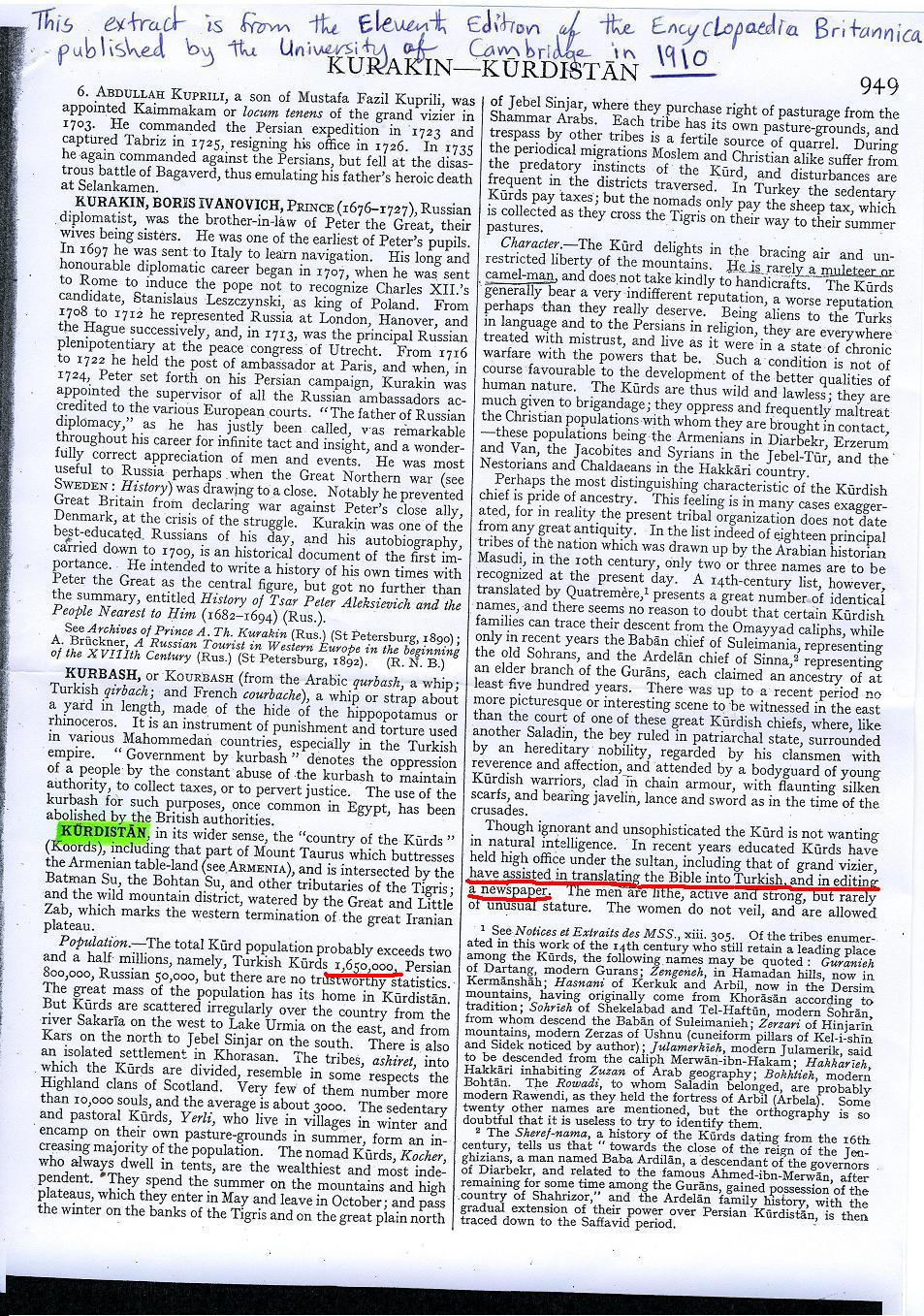
|
| Extract from the Eleventh Edition of the Encyclopedia Britannica, published in England in 1910-1911 |
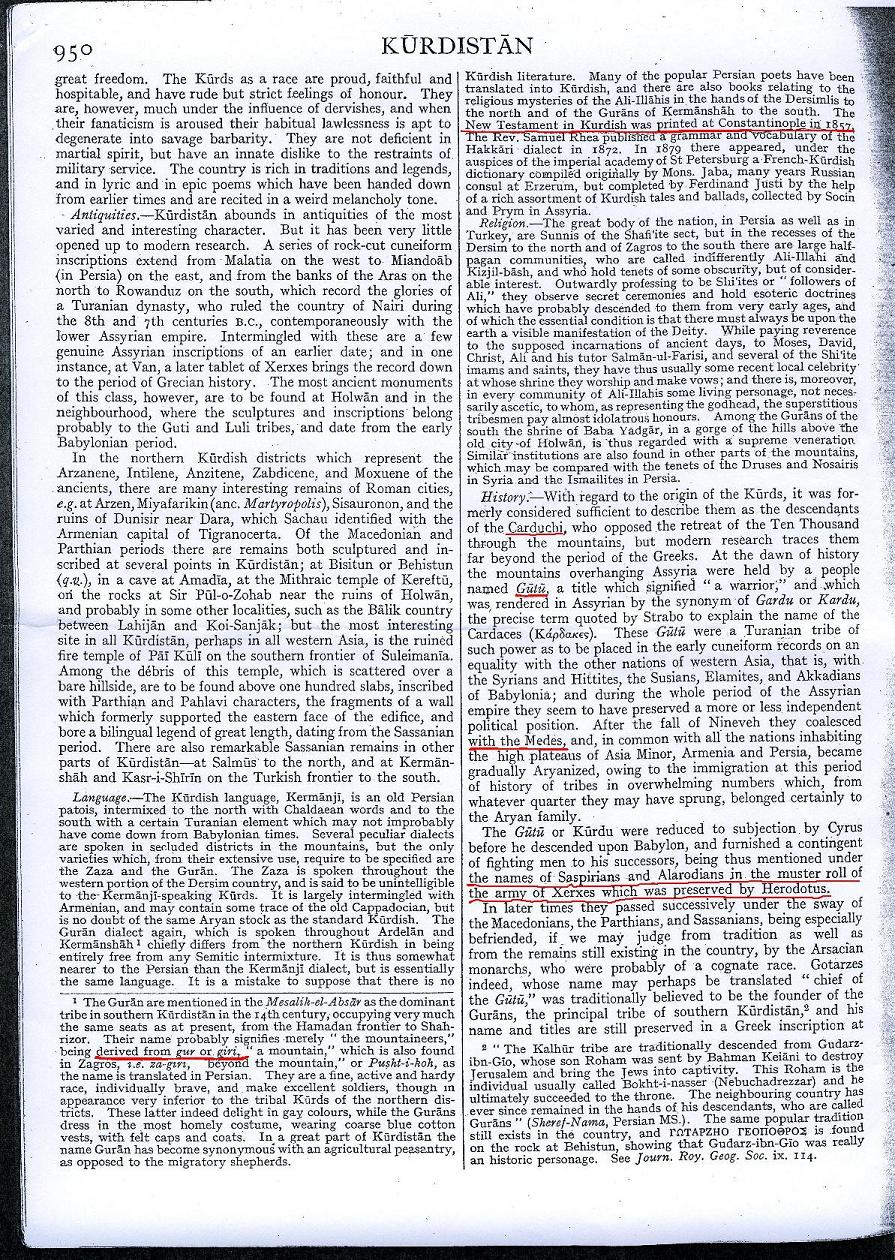
|
| Extract from the Eleventh Edition of the Encyclopedia Britannica, published in England in 1910-1911 |
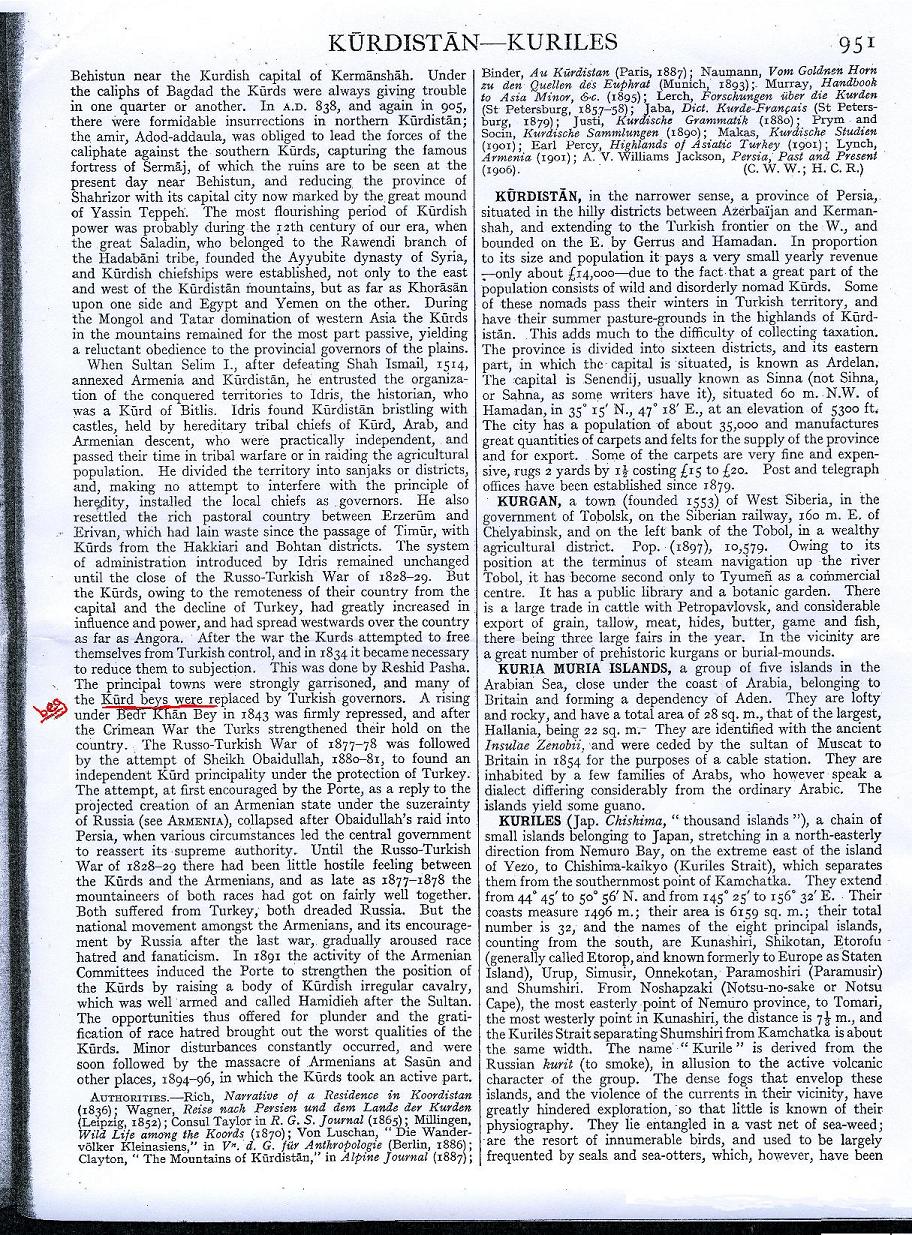
|
| Extract from the Eleventh Edition of the Encyclopedia Britannica, published in England in 1910-1911 |
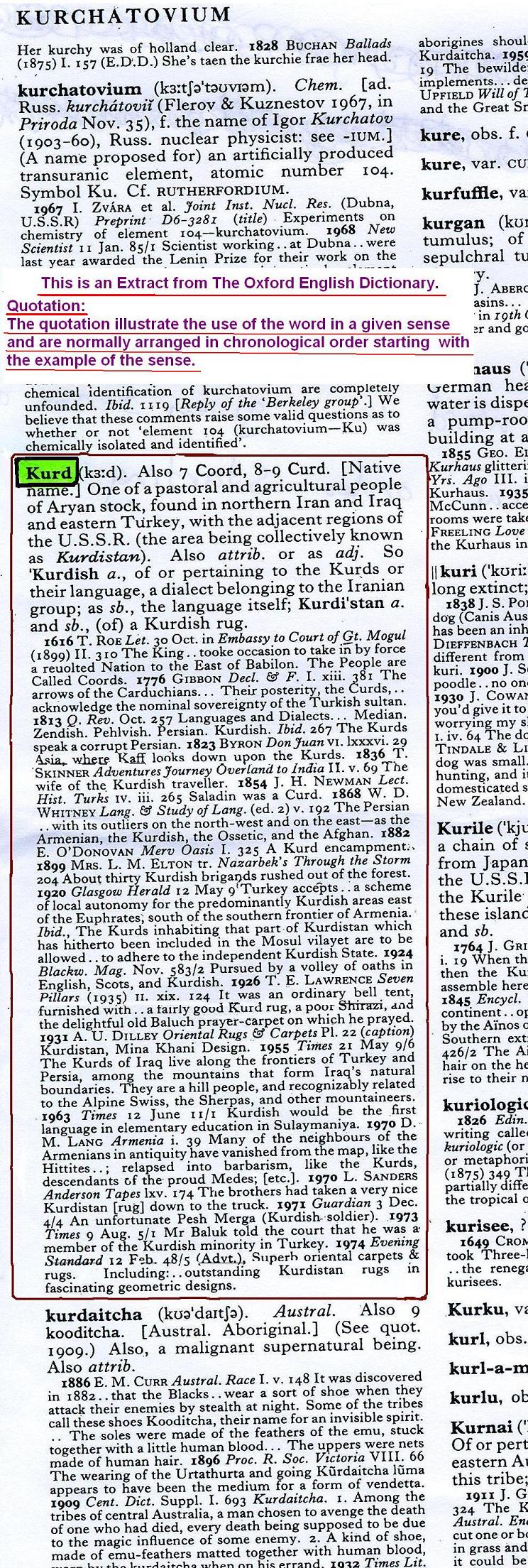
|
| An extract from the Oxford English Dictionary |
NORTHERN KURDISTAN
[Turkish occupied Kurdistan]
In Northern Kurdistan almost 20 million Kurds are forbidden to
use their own language or to describe themselves as Kurds or Kurdistani, on pain of imprisonment Kurds are officially known
as "Mountain Turks". In the 1920s and 1930s Kurds rebelled against this discrimination, and the government suppressed them
with great ferocity deporting thousands from their homeland. The continued stringent suppression of over 20 million people
has resulted in the rise of a Marxist guerrilla group.
EASTERN KURDISTAN [ Iranian occupied Kurdistan ]
In Eastern
Kurdistan the Kurds were similarly brought under control in the 1920s. In 1946 the Kurds of Mahabad succeeded in declaring
an independent republic, but it only lasted a few months, and the authorities hanged the ringleaders. Tribal chiefs were allowed
to register tribal lands as personal possessions and were welcomed into the Iranian ruling elite, in return for making sure
their tribes obeyed the government. After the shia revolution the Kurdistan Democratic Party of Iran (KDPI) rebelled after
demands for autonomy were refused by Tehran.
SOUTHERN
KURDISTN [ Kurdistan that is attached to Iraq]
There were numerous revolts against Baghdad,
mainly by Mullah Mustafa Barzani, the famous leader of the Kurdistan Democratic Party of Iraq (KDP). From 1964 until 1975
Barzani was strong enough to maintain an intermittent state of war and peace negotiations. In 1974 the governing Ba'th party
offered the Kurds autonomy, but the Kurds believed it lacked substance and they reverted to war, strongly supported and encouraged
by Iran. But In 1975 the Shah of Iran, who had supported Barzani, signed the Agreement of Algiers with the Iraqi government
and abandoned the Iraqi Kurds to their fate; as a result the Kurdish resistance virtually collapsed. In the years that followed,
many of the achievements of 1970 were gradually whittled down by the Iraqi authorities. In view of the repeated brutal attacks
on Kurdish civilians after the end of the Iran-Iraq war (e.g. Halabja, March 1988), and the forced resettlements of parts
of the Kurdish population (1989), it seems unlikely that the atmosphere in Iraq will be conducive to worthwhile literary activities
in the near future. At the time of writing, it is impossible to predict the effects of the 1991 Gulf War on the position of
the Kurds of Iraq.
The successes of the Iraqi Kurds in the field of language and education have, however, enabled them
to create an impressive literature and a fully adequate written language, and have produced a generation of Kurds whose primary
and secondary education have been in Kurdish. Such achievements will undoubtedly help the Kurds of Iraq in their future efforts
to preserve their cultural and ethnic identity.
WESTERN KURDISTAN [Syrian occupied Kurdistan]
The Syrian Ba'ath Party is not very
different from the Iraqi brutial regime of Saddam, in its suppression of kurds. It has
a long history of terror and brutality against the Kurdish people. Syria has the
worst and highest record of human right violation in the region particularly towards Kurds. Many
massacre and genocide have been committed against Kurdistanis. The government did not only murdered
the kurds, but also have forbidden the Kurdish Language in education. In additton to all of those dirty crimes,
it confiscated the kurdish land and distributed it to the Arab settlers, the policy of Arabization is still
being carried out until this moment by Syrain regime.
KURDISTANI IN EUROPE
The number of Kurdistani who have fled from oppression
in the three part of occupied Kurdistan [ Turkey, Syrian, Iranian occupied Kurdistan ] to
Europe comes to about 2.5 millions , This migration began in the late 60th and 70th mainly for political and
economical reasons,
KURDISTANI IN NORTH AMERICA / AUSTRALIA
Because of migration and refugee movements, Kurdish
communities have also been formed in North America and Australia. Although there has not been any official
statistic on kurdish population in these continents, but thier number are in hunderds of thousands.
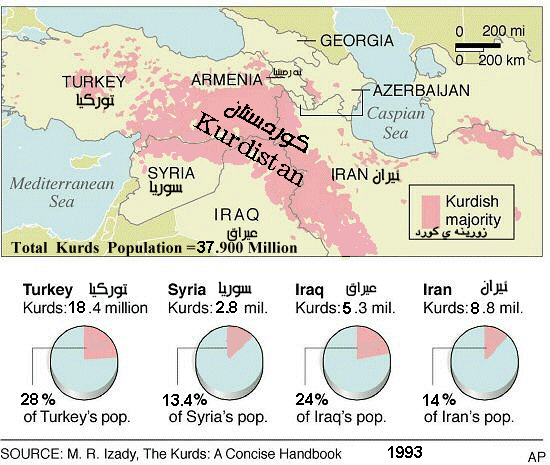
|
| Kurdistan's map with Population Figures |
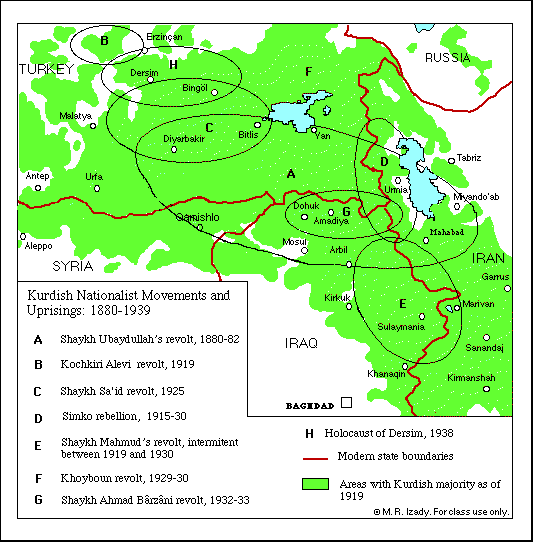
|
| Nationalist movements in Kurdistan 1880 to 1938 |

|
| Provisions of Treaty Sevres for an Independent Kurdistan in 1920 |
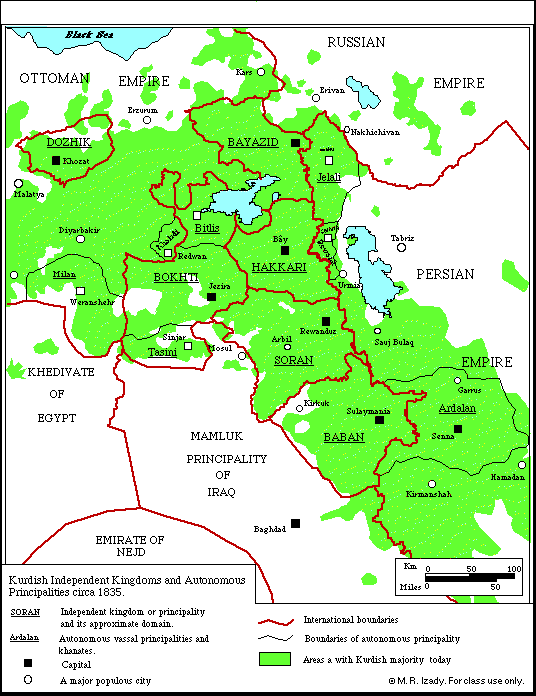
|
| Kurdish Independent Kingdoms and Principalities, Circa 1835 |
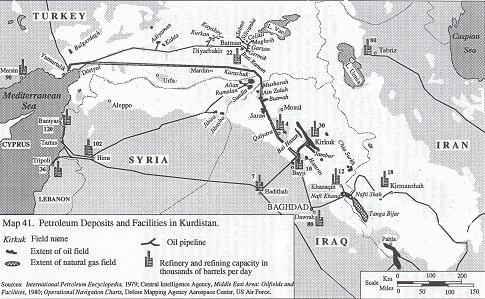
|
| Petroleum Deposits and Facilities in Kurdsitan |
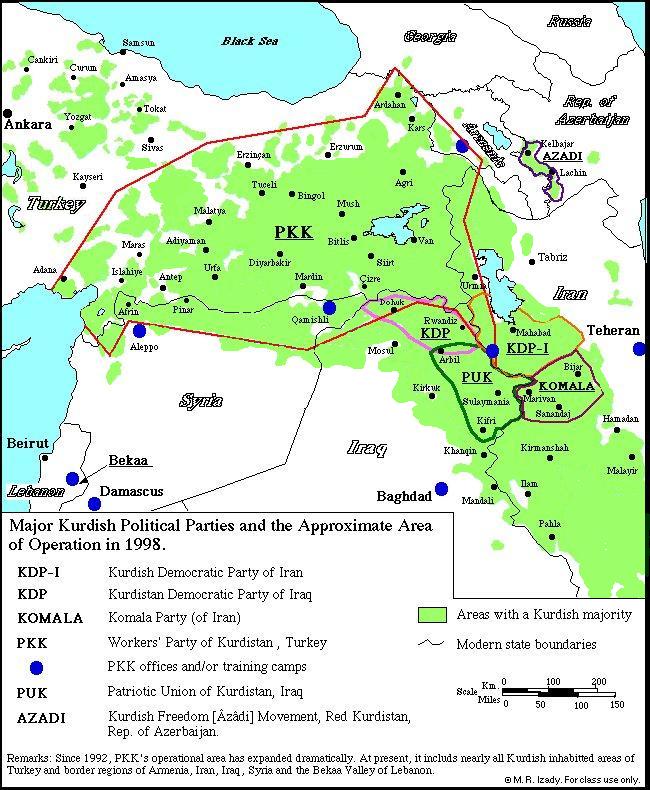
|
| Major Kurdish Political Parties in Kurdistan ,Circa 1998 |
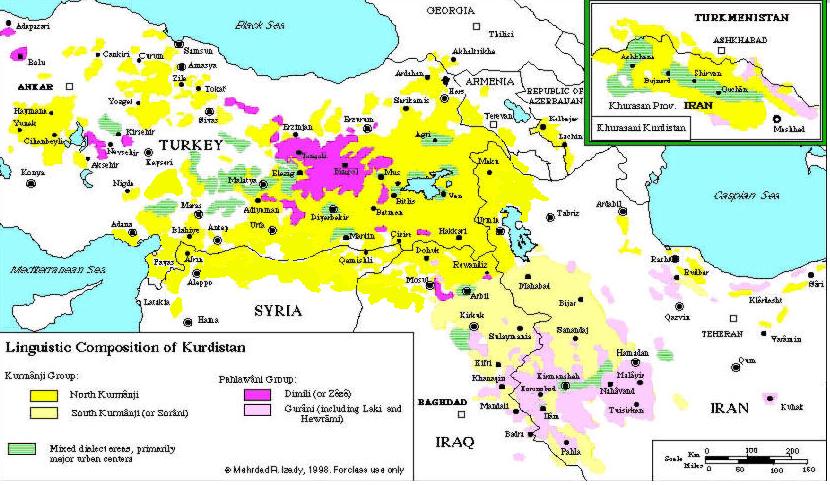
|
| Kurdish Dialects |
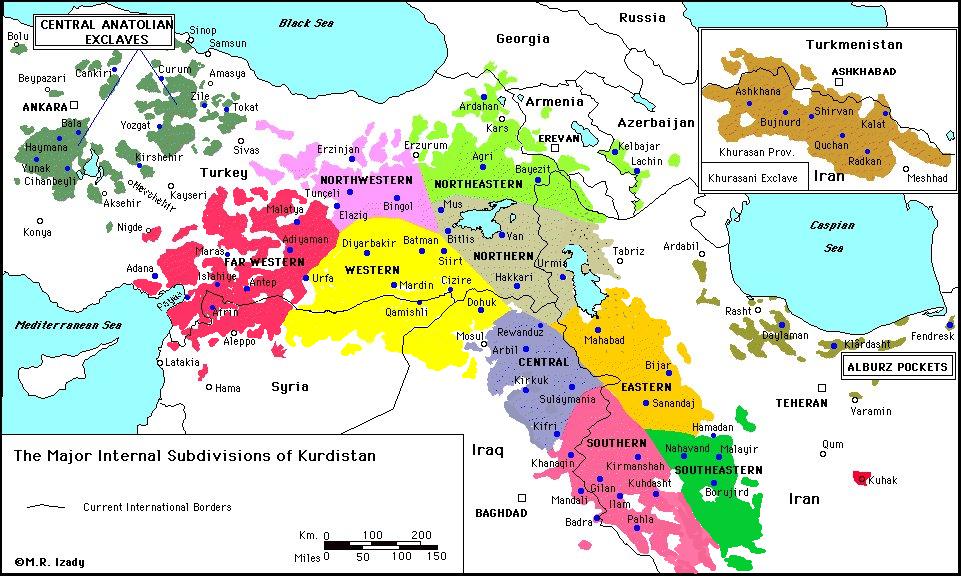
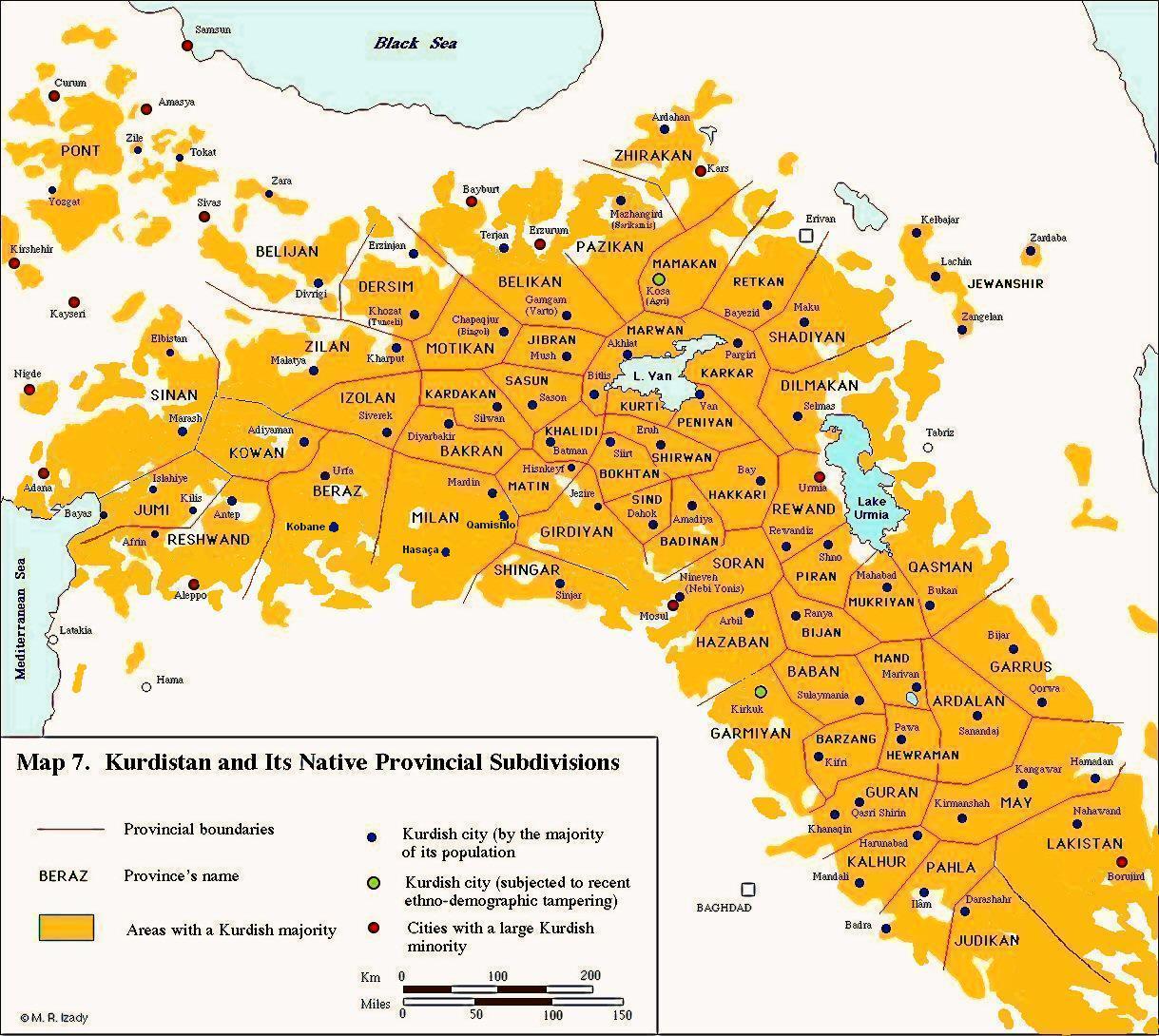
|
| Principalities (Provinces)of Kurdistan before World War I 1905 |
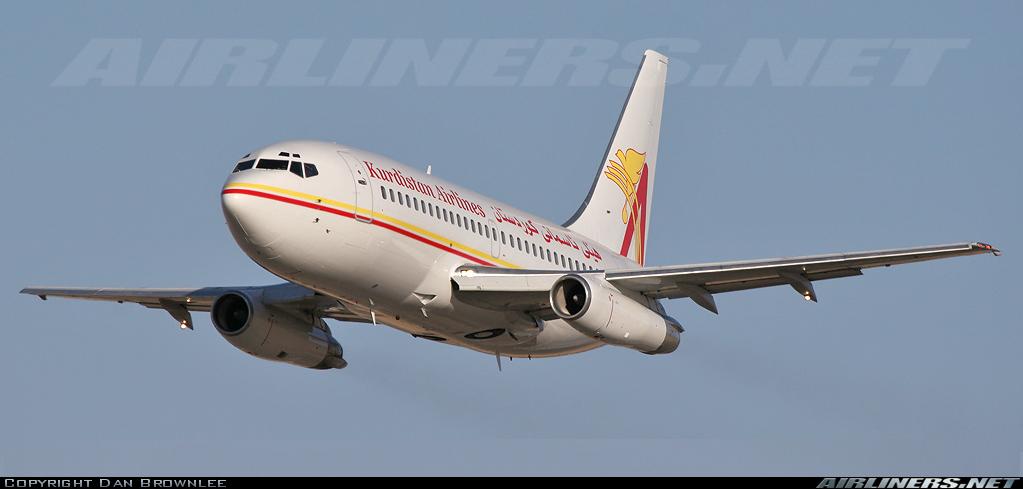
|
| Kurdistan Airlines ( Firokeyeka Kurdistan ) |
Kurdistan Airlines Website
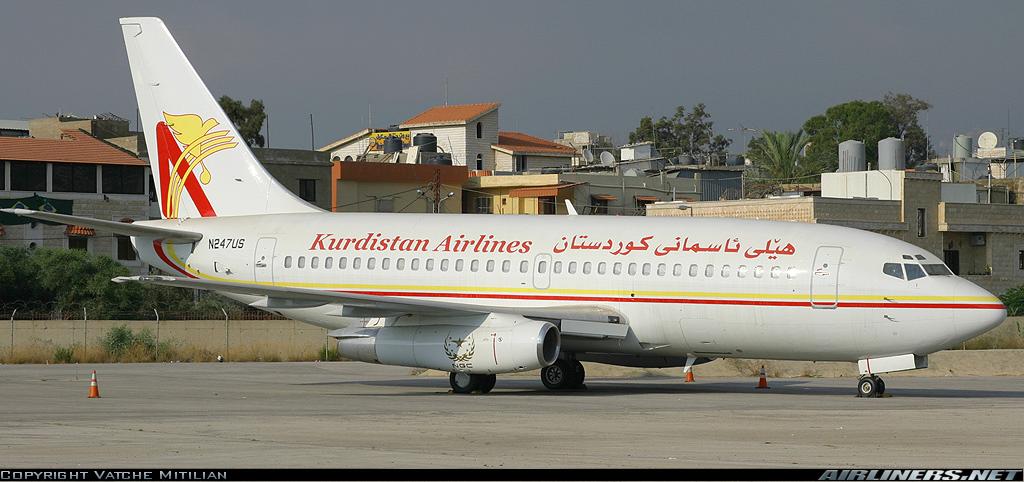
|
| Firokeyen Kurdistan ( Kurdistan Air ) |
Kurdish Poems Translated into English
|

